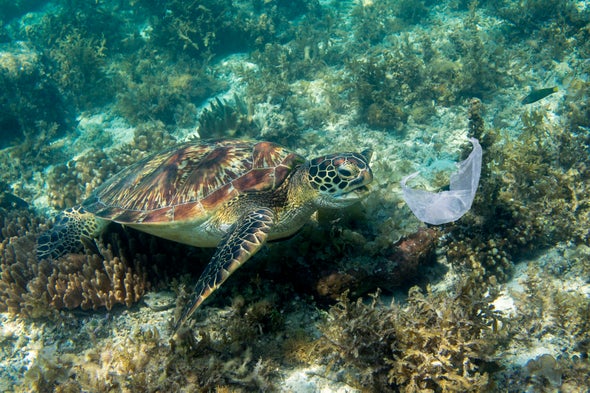(单词翻译:单击)
听力文本
This is Scientific American's 60-second Science, I'm Annie Sneed.
Plastic: It's all over the ocean. And for sea turtles, it's a killer. At least 1,000 die every year because they swallow plastic or get tangled up in it.
So why do sea turtles run into plastic so often? And why the heck are they eating it? Scientists believed the turtles may think they're biting into their prey like jellyfish when they come across some plastics.
But now a study finds that the smell of plastic may also be attractive. Researchers exposed 15 loggerhead turtles to different odors in the lab. They tested the animals' response to the smell of turtle food, distilled water, clean plastic and also to biofouled plastic—that's plastic that has marine organisms growing all over it, which is a common occurrence in the sea and on beaches.
"It gets occupied by algae and other organisms pretty quickly. And it doesn't take very long. I mean, if you leave a plastic water bottle sitting on the sand, even for a week, it's liable to get covered in these organisms. And once it's covered and biofouled, that's what makes it so appetizing to turtles."
Kayla Goforth, a Ph.D. student in biology at the University of North Carolina at Chapel Hill.

The research team found that the loggerhead turtles had similar responses to biofouled plastic as to their normal food.
"So they have to come up to breathe. And we know that they can detect airborne odors. So when they find that there's an odor of interest in the air, they'll spend an increased amount of time at the surface with their nostrils out of the water. And we found that the turtles spent more time with their nostrils out of the water when there was this biofouled plastic odor or a food odor."
The study is in the journal Current Biology.
The researchers don't know exactly what makes biofouled plastic smell so tasty to turtles. But they think a compound called dimethyl sulfide might be the culprit.
"It's a chemical that we know that sea turtles can detect. And seabirds and some fishes are also capable of detecting it. And they all use it as a feeding cue."
So the next time you're about to buy that plastic bottle, remember: it could wind up inside a sea turtle.
Thanks for listening for Scientific American — 60-Second Science. I'm Annie Sneed.
参考译文
这里是科学美国人——60秒科学系列,我是安妮·斯尼德。
塑料遍布海洋。对海龟来说,塑料是致命杀手。每年至少有1000只海龟因吞食塑料或被塑料缠住而死亡。
那为什么海龟如此频繁地接触塑料呢?他们究竟为何要吃塑料?科学家认为,当海龟碰到一些塑料制品时,它们可能会认为自己在咬水母等猎物。
但现在一项研究发现,塑料的味道可能吸引海龟。研究人员在实验室中让15只蠵龟接触不同的气味。他们测试了蠵龟对龟食、蒸馏水、清洁塑料生物附着塑料等气味的反应,生物附着塑料是周围长满海洋生物的塑料,在海水和海岸中都很常见。
“这种塑料很快就会被藻类和其它生物体占领。时间不会很久。如果将塑料水瓶立在沙滩上,即使只有一周时间,它也很容易被这些生物体覆盖。一旦塑料被生物体覆盖和堆积,就会令海龟垂涎不已。”
北卡罗来纳大学教堂山分校的生物学博士生凯拉·高福思说到。
研究团队发现,蠵龟对被生物附着塑料的反应与对正常食物的反应相似。
“它们不得不浮上水面呼吸。我们知道它们们能探测到空气中的气味。因此,当它们发现空气中有一种感兴趣的气味时,它们鼻孔露出水面的时间就会更长。我们发现,当有这种生物附着塑料气味或食物气味时,蠵龟鼻孔露出水面的时间会更长。”
这项研究发表在《当代生物学》期刊上。
研究人员尚不清楚到底是什么让生物附着塑料令蠵龟如此着迷。但他们认为化合物二甲基硫醚可能是罪魁祸首。
“我们知道这是种海龟可以探测到的化学物质。海鸟和一些鱼类也能探测到它。它们都把二甲基硫醚当作食物线索。”
因此,下次买塑料瓶时,记住:它可能最终会进入海龟体内。
谢谢大家收听科学美国人——60秒科学。我是安妮·斯尼德。
译文为可可英语翻译,未经授权请勿转载!
重点讲解
重点讲解:
1. run into 意外碰到;
We had the misfortune to run into a violent storm.
我们不幸遭遇了猛烈的暴风雨。
2. be liable to 有…危险的;可能遭受…的;有…倾向的;
You are more liable to injury if you exercise infrequently.
不经常运动就更容易受伤。
3. be capable of 有…能力的;能够…的;
Every student in the class is capable of passing the exam.
班上每个同学都有能力通过这次考试。
4. wind up 最终沦落到;最终落得;(以…)告终;
He could wind up in gaol.
他可能最后会进监狱。


